Frederiksberg
Frederiksberg (Danish pronunciation: [fʁeðʁeksˈpɛɐ̯ˀ]) is a part of the Capital Region of Denmark. It is formally an independent municipality, Frederiksberg Municipality,[1] separate from Copenhagen Municipality, but both are a part of the City of Copenhagen.[2][3] It occupies an area of less than 9 km2 and had a population of 103,192 in 2015.[4]
Frederiksberg | |
|---|---|
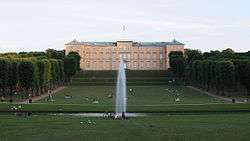 Frederiksberg Palace seen from the park | |
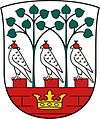 Seal | |
| Coordinates: 55°40′N 12°32′E | |
| Country | Denmark, Copenhagen |
| Region | Capital (Hovedstaden) |
| Municipality | Frederiksberg |
| Government | |
| • Mayor | Jørgen Glenthøj |
| Area (co-extensive with its municipality) | |
| • Total | 8.7 km2 (3.4 sq mi) |
| Population (2015) | |
| • Total | 103,192 |
| • Density | 11,861/km2 (30,720/sq mi) |
| Time zone | UTC+1 (Central Europe Time) |
| • Summer (DST) | UTC+2 |
| Website | www |
Frederiksberg is an enclave surrounded by Copenhagen Municipality. Some sources ambiguously refer to Frederiksberg as a quarter or neighbourhood of Copenhagen,[3] being one of the four municipalities that constitute the City of Copenhagen (the other three being Copenhagen, Tårnby and Dragør).[5] However, Frederiksberg has its own mayor and municipal council, and is fiercely independent.
Frederiksberg is an affluent area.[3], characterised by its many green spaces, such as the Frederiksberg Gardens, Søndermarken, and Hostrups Have.[6] Some institutions and locations that are widely considered to be part of Copenhagen are actually located in Frederiksberg. For example, Copenhagen Zoo as well as several stations of the Copenhagen Metro (the stations Forum, Frederiksberg, Fasanvej, Lindevang, and Flintholm) are located in Frederiksberg. The Copenhagen S-train system also has several stations in Frederiksberg, including Peter Bangs Vej station and Flintholm station.
History
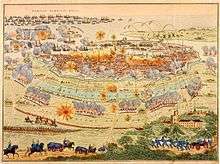
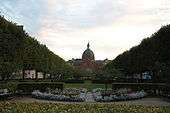
Frederiksberg's original name was Tulehøj (= Thyle-hill),[7] indicating that a thul (= thyle) lived there, the reciter of eldritch times. The term is known from the Snoldelev rune stone.[8] In Beowulf, Unferth holds the same title. In Håvamål, Odin himself is referred to as "the old thul".[9] Thula translates as "song", like in the Rigsthula poem from the Edda. By 1443 the name Tulehøj was spelled Tulleshøy. It was regarded as Copenhagen's border to the west.[10] People lived here since the Bronze Age.
The history of Frederiksberg goes back to 2 June 1651 when King Frederik III gave 20 Danish—Dutch peasants the rights to settle at Allégade (= allé = tree-lined street, gade = street), and founded the town then named "Ny Amager" (= New Amager) or "Ny Hollænderby" (= New Dutchman-town). Farming was not very successful, and in 1697 most of the town burned down. This meant that the peasants were unable to pay taxes, and the land reverted to the crown by Frederik III's son Christian V.
In 1700–1703, King Frederik IV built a palace on top of the hill known as Valby Bakke (bakke = hill). He named the palace Frederichs Berg, and the rebuilt town at the foot of the hill consequently changed its name to Frederiksberg. A number of the local houses were bought by wealthy citizens of Copenhagen who did not farm the land, but rather used the properties as country houses.
The town changed slowly from a farming community to a merchant town, with craftsmen and merchants. During the summer rooms were offered for rent, and restaurants served food to the people of Copenhagen who had left the cramped city for the open land, and to be near the royals.
Initially the town grew slowly with population growing from 1,000 in 1770, to 1,200 in 1800, and to 3,000 in 1850.
In 1852, Parliament removed restrictions which prohibited permanent construction outside Copenhagen's city walls. Almost immediately numerous residential areas were constructed, starting in the eastern part near Copenhagen, and ending in the western part farthest away from Copenhagen in 1950. This led to rapid population growth; in 1900 the population reached 80,000, and in 1950 Frederiksberg peaked with a population of 120,000.
Today Frederiksberg consists almost entirely of 3- to 5-story residential houses, large single-family homes, and large parks; only a few small areas with light industry remain.
Geography
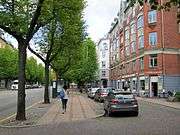
Frederiksberg, which lies west of central Copenhagen, is completely surrounded by boroughs forming part of the city of Copenhagen – the result of an expansion of the Copenhagen Municipality's boundary in 1901, which nevertheless did not include Frederiksberg in the list of municipalities to be incorporated in the enlarged area. Frederiksberg is thus effectively a municipal island within the country's capital – a unique phenomenon in present-day Europe. Other than administratively, however, it is largely indistinguishable in character from the districts of Copenhagen city which surround it.[3]
Frederiksberg has several stations on the Copenhagen Metro system, and is home to the tallest residential structure in Denmark and the second tallest residential building in Scandinavia: the 102-metre high Domus Vista.
Culture
The Danmark Rundt cycling race traditionally finishes on Frederiksberg Alle, often in a sprint finish.
Education
Frederiksberg houses the University of Copenhagen's Frederiksberg Campus, Copenhagen Business School, 9 public schools (run by the municipality), 3 private schools, 1 technical college, and more.
The Lycée Français Prins Henrik, a French international school, is in Frederiksberg.[11]
Shopping
The 3 streets Gammel Kongevej, Godthåbsvej, and Falkoner Alle are the busiest shopping streets. The town also houses the Frederiksberg Centret shopping mall.
Demography
Population of Frederiksberg (from 1769):
|
|
|
|
Transport
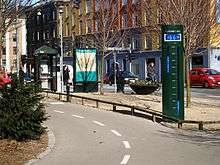
The town is served by the Frederiksberg station and the Fasanvej station, opened in 2003 on the Copenhagen Metro. It serves the M1, M2 and M3 (the City Circle Line) lines and is connected with bus services.
The S-Train urban rail and suburban rail network can be reached through Peter Bangs Vej station, Fuglebakken station and Grøndal station.[12]
Notable residents
Arts & Writing
- Kamma Rahbek (1775–1829) a Danish artist, salonist and lady of letters
- Asger Hamerik (1843–1923) a Danish composer of classical music
- Marie Luplau (1848–1925) a Danish artist and educator, active in the women's movement
- Axel Olrik (1864–1917) a Danish folklorist and scholar of mediaeval historiography and methodical study of oral narrative
- Marie Krøyer (1867–1940) a Danish Skagen Painter and wife of Peder Severin Krøyer and Hugo Alfven
- Frederik Lange (1871–1941) a Danish painter of portraits but later in Skagen of landscapes
- Harald Giersing (1881-1927) a Danish painter, developed classic modernism
- Robert Storm Petersen (1882–1949) known as Storm P. a Danish cartoonist, writer, animator, painter and humorist
- Gerda Wegener (1886–1940) a Danish illustrator and painter, art nouveau and later art deco.
- Einar Utzon-Frank (1888-1955) was a Danish sculptor and professor at the Royal Danish Academy of Fine Arts[13]
- Mogens Wöldike (1897–1988) a Danish conductor, choirmaster, organist and scholar
- Gottfred Eickhoff (1902–1982) a Danish sculptor, inspired by French trends
- Ole Wanscher (1903–1985) a Danish furniture designer, of the Scandinavian Design movement
- Helen Schou (1905–2006) a Danish sculptor most known for her works of horses.
- Victor Brockdorff (1911–1992) a Danish painter who joined the Odsherred Painters
- Erik Christian Haugaard (1923–2009) a Danish-born American writer of children's books, translated works of HC Andersen.
- Leif Panduro (1923–1977) a Danish writer, novelist, short story writer, dramatist and also a dentist
- Frank Jæger (1926-1977) a Danish writer of poetry and radio plays
- Ib Mossin (1933–2004) a Danish actor, singer, director and heartthrob
- Anders Bodelsen (born 1937) a prolific Danish writer primarily associated with the 1960 new-realism
- Roald Als (born 1948) a Danish cartoonist
Acting & Entertainment
- Carl Theodor Dreyer (1889–1968) a Danish film director, regarded by many as one of the greatest directors in cinema
- Henning Carlsen (1927–2014) a Danish film director and screenwriter, noted for documentaries and use of cinéma vérité
- Birgitte Price (1934–1997) a Danish actress of the 1950s and 1960s
- Bo Christensen (born 1937) a Danish film producer
- Jesper Langberg (born 1940) a Danish film actor, appearing in over 50 films since 1965
- Jørgen de Mylius (born 1946) a Danish radio and TV personality
- Louise Frevert (born 1953) belly dancer, pornographic actress and member of parliament 2001-2007
- Claes Bang (born 1967) a Danish actor and musician
- Sofie Gråbøl (born 1968) a Danish actress
- Christina Chanée (born 1979) a Danish-Thai pop singer, lives in Frederiksberg
Politics & Public Office
- Carl Christian Hall (1812–1888) a Danish statesman [14] and Council President of Denmark 1857-1859 and 1860-1863
- Viggo Kampmann (1910–1976) leader of the Danish Social Democrats, Prime Minister of Denmark 1960-1962
- Emil Balslev (1913 – executed 1944) a surveyor and member of the Danish resistance
- Torben Tryde (1916–1998) a Danish lieutenant colonel, writer, olympian, resistance fighter and the last person to be appointed kammerjunker by the Danish Court.
- Per Stig Møller (born 1942) a Danish politician, a member of the Folketing for the Conservative People's Party 1984–2015, held several ministerial posts
- Hans Hækkerup (1945–2013) a Danish politician, member of parliament and Minister of Defence
- Erland Kolding Nielsen (1947–2017) Director General and CEO of the Danish Royal Library
- Lars Barfoed (born 1957) a Danish politician representing the Conservative People's Party, and its party leader 2011-2014
- Pia Gjellerup (born 1959) a Danish politician representing the Social Democrats, Member of Folketinget since 1987. Has held three cabinet positions; solicitor by profession
- Christian Friis Bach (born 1966) the Secretary General of the Danish Refugee Council
- Ida Auken (born 1978) a Danish politician and member of Parliament
Science & Design
- Ferdinand Meldahl (1827–1908) a Danish architect, reconstruction of Frederiksborg Castle after the fire in 1859.
- Knud Andersen (1867–1918) a Danish zoologist who researched bats
- Kaare Klint (1888–1954) a Danish architect and furniture designer, father of modern Danish furniture design
- Finn Juhl (1912–1989) a Danish architect, interior and industrial designer, helped create "Danish design" and introduced Danish Modern to America
- Peter Naur (1928–2016) a Danish computer science pioneer and Turing award winner
- Per Brinch Hansen (1938–2007) a Danish-American computer scientist
- Sir Bent Skovmand (1945—2007) a Danish plant scientist and conservationist.
Sport
- Charles Winckler (1867–1932) a Danish athlete and gold medallist in the tug of war at the 1900 Summer Olympics
- Christian Grøthan (1890–1951) a Danish football player, who played 31 games and scored three goals for the Denmark national football team from 1915 to 1923 and competed at the 1920 Summer Olympics
- Ebbe Schwartz (1901–1964) a Danish football administrator.
- Pauli Jørgensen (1905–1993) a Danish amateur football player and manager, played 297 matches and scored 288 goals for Boldklubben Frem and played 47 matches and scored 44 goals for the Denmark
- Torben Ulrich (born 1928) a Danish writer, musician, filmmaker, painter, director, performer and former amateur then professional tennis player.
- Per Lyngemark (1941–2010) a Danish amateur track cyclist, gold medallist at the 1968 Summer Olympics
- Finn Laudrup (born 1945) a Danish former football player, played 19 matches and scored 6 goals for Denmark
- Per Røntved (born 1949) a Danish former footballer with 435 club caps. He was 1972 Danish Player of the Year, and was the first to earn 75 caps for the Denmark national football team, doing so from 1970 to 1982.
- Ivan Nielsen (born 1956) a Danish former professional football player, capped 51 times for the Denmark
- Kent Nielsen (born 1961) a Danish former footballer, 462 club caps, 54 for Denmark, head coach of Odense Boldklub,
- Jan Bartram (born 1962) a Danish former professional football player, 275 club caps and 32 for Denmark
- Michael Laudrup (born 1964) a Danish former professional footballer, 479 club caps and 104 for Denmark
- Søren Colding (born 1972) a Danish former professional football player, 370 club caps and 27 for Denmark
- Thomas Delaney (born 1991) a Danish footballer, 300 club caps and 21 for Denmark
- Rasmus Winther (born 1999) a League of Legends player
Twin towns[15]
|
|
|
References
- "Is Frederiksberg part of the City of Copenhagen?". kk.dk. The City of Copenhagen. Archived from the original on 25 April 2016. Retrieved 15 April 2016.
- "Areas of Copenhagen". visitcopenhagen.com. VisitCopenhagen / Wonderful Copenhagen. Archived from the original on 19 April 2016. Retrieved 15 April 2016.
- "Guide to Frederiksberg in Copenhagen". visitcopenhagen.com. Wonderful Copenhagen. Archived from the original on 13 April 2016. Retrieved 16 April 2016.
Frederiksberg is a fashionable part of Copenhagen with excellent shopping opportunities and green spaces.
- "Statistikbanken Table FOLK1". Statistikbanken.dk. Archived from the original on 24 March 2015. Retrieved 11 February 2015.
- "Regioner, landsdele og kommuner. v 1.0: 2007-". Statistics Denmark. Retrieved 6 June 2018. See also: Provinces of Denmark.
- "Hostrups Have, Falkoner Allé". Retrieved 3 January 2019.
- "Gravhøien paa Dyrehavegaard" (PDF). Archived (PDF) from the original on 3 October 2011. Retrieved 15 November 2010.
- "Runer og Runesten - Nationalmuseet". natmus.dk. Archived from the original on 26 May 2012. Retrieved 1 May 2018.
- "de beste bron van informatie over normanni i. Deze website is te koop!". normannii.org. Retrieved 14 November 2010.
- "Rostgaard: Dend Kongelige Residents= og Stabel=Stad Kiøbenhavn". Eremit.dk. 17 March 2002. Archived from the original on 19 July 2011. Retrieved 14 November 2010.
- "Plan d’accès" Archived 2015-04-27 at the Wayback Machine/Sådan finder du skolen Archived 2015-04-27 at the Wayback Machine. Lycée Français Prins Henrik. Retrieved on 21 April 2015. "Federiksberg Alle 22A, 1820 Frederiksberg, Denmark"
- "S-tog stationer i København, Danmark | Nelso" (in Danish). Nelso.dk. Retrieved 14 November 2010.
- Kulturarvsstyrelsen. "Artist: Einar Utzon-Frank". Kunstindeks Danmark & Weilbachs Kunstnerleksikon. Archived from the original on 7 August 2011.
- 1911 Encyclopædia Britannica, Volume 12, Hall, Carl Christian retrieved 1 June 2018
- "Frederiksberg Municipality – Twin Towns" (in Danish). copyright 2007-2009 Frederiksberg Municipality. Archived from the original on 15 June 2011. Retrieved 3 September 2017. External link in
|publisher=(help)
External links
| Wikimedia Commons has media related to Frederiksberg. |

- Frederiksberg official website